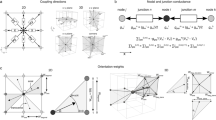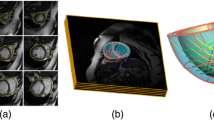Abstract
Cardiovascular modelling has been a major research subject for the last decade. Different cardiac models have been developed at a cellular level as well as at the whole organ level. Most of these models are defined by a comprehensive cellular modelling using continuous formalisms or by a tissue-level modelling often based on discrete formalisms. Nevertheless, both views still suffer from difficulties that reduce their clinical applications: the first approach requires heavy computational resources while the second one is not able to reproduce certain pathologies.
This paper presents an original methodology trying to gather advantages from both approaches, by means of a hybrid model mixing discrete and continuous formalisms. This method has been applied to define a hybrid model of cardiac action potential propagation on a 2D grid of endocardial cells, combining cellular automata and a set of cells defined by the Beeler-Reuter model. For simulations under physiological and ischemic conditions, results show that the action potential propagation as well as electrogram reconstructions are consistent with clinical diagnosis. Finally, the advantage of the proposed approach is discussed within the frame of cardiac modelling and simulation.
Similar content being viewed by others
REFERENCES
Ahlfeldt, H.,H. Tanaka, M.E. Nygards, T. Furukawa and O. Wigertz (1988).Computer simulation of cardiac pacing.Pacing and Clinical Electrophysiology 11: 174–184.
Aliev, R.R.and A.V. Panfilov (1996).A simple two-variable model of cardiac excitation. Chaos,Solitons and Fractals 7: 293–301.
Auger, P.and R.B. de la Parra (2000).Methods of aggregation of variables in population dynamics.C.R.Acad.Sci.Paris,Sciences de la vie/Life Sciences: 665–674.
Beeler, G.W.and H. Reuter (1977).Reconstruction of the action potential of ventricular myocardial fibres.Journal of Physiology 268: 177–210.
Blanc, O.(2002).A Computer Model of Human Atrial Arrhythmia.PhD Thesis,Ecole Polytechnique Fédérale de Lausanne.
Dawant, B.M.(1995).Knowledge-based systems for intelligent patient monitoring and management in critical care environments.The Biomedical Engineering Handbook: 2 746–2756.CRC Press, Boca Raton.
de Lara, J.and H. Vangheluwe (2002).Computer aided multi-paradigm modelling to process petri-nets and statecharts.International Conference on Graph Transformation (ICGT). Barcelona,Spain,2002: 239–253.Lecture Notes in Computer Science,Springer-Verlag, Berlin.
Hernández, A.(2000).Fusion de signaux et de modèles pour la caractérisation d'arythmies cardiaques.PhD Thesis,Université de Rennes1.
Hernández, A.,G. Carrault and F. Mora (2002).Model-based interpretation of cardiac beats by evolutionary algorithms:signal and model interaction.Artificial Intelligence in Medicine 26: 211–235.
Hernández, A.I.,G. Carrault, F. Mora and A. Bardou (2000).Overview of CARMEM:A new dynamic quantitative cardiac model for ECG monitoring and its adaptation to observed signals.Acta Biotheoretica 48: 303–322.
Holden, A.V.,M.J. Poole and J.V. Tucker (1995).Reconstructing the heart.Chaos,Solitions and Fractals 5: 691–704.
Joyner, R.W.,F. Ramon and J.W. Moore (1975).Simulation of action potential propagation in an inhomogeneous sheet of coupled excitable cells.Circulation Research 36: 654–661.
Keener, J.and J. Sneyd (1998).Mathematical Physiology.Springer-Verlag, Berlin.
Luo, C.H.and Y. Rudy (1991).A model of the ventricular cardiac action potential. Depolarization,repolarization,and their interaction.Circulation Research 68:1 501–1526.
Malik, M.,T. Cochrane, D.W. Davies and A.J. Cam (1987).Clinically relevant computer model of cardiac rhythm and pacemaker/heart interaction.Medical and Biological Engineering and Computing 25: 504–512.
McCulloch, A.,J.B. Bassingthwaighte, P.J Hunter and D. Noble (1998).Computational biology of the heart:From structure to function.Progress in Biophysics and Molecular Biology 63: 153–155.
Noble, D.(2002).Modeling the heart-from genes to cells to the whole organ.Science 295: 1 678–1682.
Poole, M.J.,A.V. Holden and J.V. Tucker (2002).Hierarchical reconstructions of cardiac tissue. Chaos,Solitons and Fractals 13:1 581–1612.
Pormann, J.B.(1999).A Modular Simulation System for the Bidomain Equations.PhD Thesis, Department of Electrical and Computer Engineering, Duke University.
Sahakian, A.V.,G.A. Myers and N. Maglaveras (1992).Unidirectional block in cardiac fibers: Effects of discontinuities in coupling resistance and spatial changes in resting membrane potential in a computer simulation study.IEEE Transactions on Biomedical Engineering 39: 510–522.
Schaff, J.,C. Fink, B. Slepchenko, J. Carson and L. Loew (1997).A general computational framework for modelling cellular structure and function.Biophysical Journal 73: 1 135–1146.
Takahashi, K., K. Yugi, K. Hashimoto, Y. Yamada, C.J. Pickett and M.Tomita (2002). Computational challenges in cell simulation:A software engineering approach.IEEE Intelligent Systems 17:64–71.
Vangheluwe, H.(2000).DEVS as a common denominator for multi-formalism hybrid systems modelling.IEEE International Symposium on Computer-Aided Control Systems Design. pp. 129–135.IEEE,Anchorage.
Vangheluwe, H.(2001).Multi-Formalism Modelling and Simulation.PhD Thesis,Universiteit Gent.
Vangheluwe, H.and J. de Lara (2002).Meta-models are models too.Proceedings of the 2002 Winter Simulation Conference.Vol.1.pp. 597–605.IEEE,San Diego.
Virag, N.,J.M. Vesin and L. Kappenberger (1998).A computer model of cardiac electrical activity for the simulation or arrhytmias.Pacing and Clinical Electrophysiology 21: 2 366–2371.
Zeigler, B.P.,H. Praehofer and T.G. Kim (2000).Theory of Modeling and Simulation-Second Edition Integrating Discrete Event and Continuous Complex Dynamic Systems.Academic Press, San Diego.
Author information
Authors and Affiliations
Rights and permissions
About this article
Cite this article
Defontaine, A., Hernández, A. & Carrault, G. Multi-Formalism Modelling and Simulation: Application to Cardiac Modelling. Acta Biotheor 52, 273–290 (2004). https://doi.org/10.1023/B:ACBI.0000046598.69328.03
Issue Date:
DOI: https://doi.org/10.1023/B:ACBI.0000046598.69328.03




